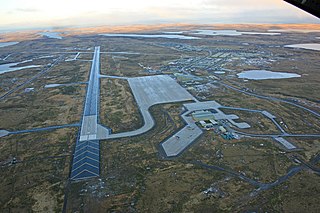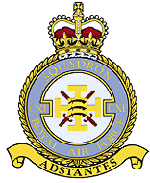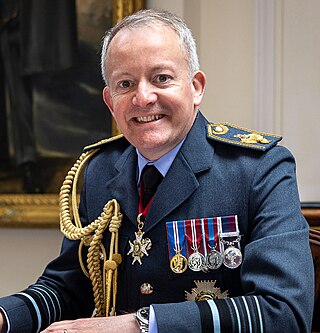
The Panavia Tornado Air Defence Variant (ADV) is a long-range, twin-engine swing-wing interceptor aircraft developed by the European Panavia Aircraft GmbH consortium. It was a specialised derivative of the multirole Panavia Tornado.

RAF Mount Pleasant is a Royal Air Force station in the British Overseas Territory of the Falkland Islands. The airfield goes by the motto of "Defend the right" and is part of the British Forces South Atlantic Islands (BFSAI). Home to between 1,000 and 2,000 British military personnel, it is about 33 miles (53 km) southwest of Stanley, the capital of the Falklands, on the island of East Falkland. The world's longest corridor, 2,600 feet (800 m) long, links the barracks, messes, and recreational and welfare areas of the station, and was nicknamed the "Death Star Corridor" by personnel.

Royal Air Force Lossiemouth or more commonly RAF Lossiemouth is a military airfield located on the western edge of the town of Lossiemouth in Moray, north-east Scotland.

Royal Air Force Coningsby or RAF Coningsby, is a Royal Air Force (RAF) station located 13.7 kilometres (8.5 mi) south-west of Horncastle, and 15.8 kilometres (9.8 mi) north-west of Boston, in the East Lindsey district of Lincolnshire, England. It is a Main Operating Base of the RAF and home to three front-line Eurofighter Typhoon FGR4 units, No. 3 Squadron, No. 11 Squadron and No. 12 Squadron. In support of front-line units, No. 29 Squadron is the Typhoon Operational Conversion Unit and No. 41 Squadron is the Typhoon Test and Evaluation Squadron. Coningsby is also the home of the Battle of Britain Memorial Flight (BBMF) which operates a variety of historic RAF aircraft.

Number 111 (Fighter) Squadron, also known as No. CXI (F) Squadron and nicknamed Treble One, was a squadron of the Royal Air Force. It was formed in 1917 in the Middle East as No. 111 Squadron of the Royal Flying Corps during the reorganisation of the Egyptian Expeditionary Force after General Edmund Allenby took command during the Sinai and Palestine Campaign. The squadron remained in the Middle East after the end of the First World War until 1920 when it was renumbered as No. 14 Squadron.

Royal Air Force Germany, commonly known as RAF Germany, and abbreviated RAFG, is a former command of the Royal Air Force (RAF) and part of British Forces Germany (BFG). It consisted of units located in Germany, initially in what was known as West Germany as part of the British Air Forces of Occupation (BAFO) following the Second World War, and later as part of the RAF's commitment to the defence of Europe during the Cold War. The commander of RAFG doubled as commander of NATO's Second Allied Tactical Air Force (2ATAF). Its motto was 'Keepers of the Peace'.

Number 56 Squadron, also known as No. 56 Test and Evaluation Squadron (TES), nicknamed the Firebirds for their ability to always reappear intact regardless of the odds, is one of the oldest and most successful squadrons of the Royal Air Force, with battle honours from many of the significant air campaigns of both the First and Second World Wars.

Air Chief Marshal Sir Anthony John Crowther "Tony" Bagnall, is a retired senior Royal Air Force officer and former Vice-Chief of the Defence Staff.
Air Commodore David Harrison, BSc RAF, is a retired RAF Officer and former Commandant of the Air Cadet Organisation (ACO).
Air Commodore Jon Chitty, OBE RAF, was Commandant of the Air Training Corps (ATC) from 3 May 2002 until July 2005.

The Royal Auxiliary Air Force (RAuxAF), formerly the Auxiliary Air Force (AAF), together with the Air Force Reserve, is a component of His Majesty's Reserve Air Forces. It provides a primary reinforcement capability for the regular service, and consists of paid volunteers who give up some of their weekends, evenings and holidays to train at one of a number of squadrons around the United Kingdom. Its current mission is to provide trained personnel in support of the regular RAF.

Air Commodore Ian Richard William Stewart is a retired British Royal Air Force officer. His last posting was as the United Kingdom National Military Representative at Supreme Headquarters Allied Powers Europe. He was Commandant Air Cadets between 2008 and 2010, and Air Commodore, Royal Air Force Reserve from 2014.
Air Vice Marshal John Frederick George Howe, was a senior Royal Air Force officer in the 1970s and 1980s. He flew combat missions in the Korean War and North Sea interceptor air patrols during the Cold War, finishing his career as the Commandant General RAF Regiment and RAF Provost Marshal and Director General Security. Howe also served as the sixteenth Commandant of the Royal Observer Corps between 1977 and 1980.

Air Chief Marshal Sir Simon Bryant, is a former Royal Air Force officer, who served as Commander-in-Chief of Air Command, and he was the second-most senior officer in the service until this post was dis-established in March 2012. He was appointed in 2010, following the sudden death of the then Commander-in-Chief, Air Chief Marshal Sir Christopher Moran, having served as Deputy Commander-in-Chief Personnel for just over a year. He was knighted in the 2011 New Year Honours List.
Air Commodore Simon Owen Falla, is a retired senior Royal Air Force officer. He was Deputy Commander and Chief of Staff Joint Helicopter Command from December 2006 until his retirement in June 2010.

Air Marshal Peter Brett Walker, was a Royal Air Force officer who served as Lieutenant Governor of Guernsey from 2011 to 2015.

The United Kingdom (UK) operated the McDonnell Douglas F-4 Phantom II as one of its principal combat aircraft from 1968 to 1992. The UK was the first export customer for the F-4 Phantom, which was ordered in the context of political and economic difficulties around British designs for the roles that it eventually undertook. The Phantom was procured to serve in both the Royal Navy's Fleet Air Arm (FAA) and the Royal Air Force (RAF) in several roles including air defence, close air support, low-level attack and tactical reconnaissance.

Air Chief Marshal Sir Richard John Knighton, is a senior Royal Air Force (RAF) officer and professional engineer, currently serving as Chief of the Air Staff, the professional head of the RAF, since 2 June 2023. He previously served as Assistant Chief of the Air Staff from January 2015 to January 2017, Deputy Chief of Defence Staff at the Ministry of Defence, and as Deputy Commander Capability at RAF Air Command. Knighton is notable for being the first Chief of the Air Staff who is not a military pilot or indeed aircrew-qualified.

Royal Air Force Leuchars or more simply RAF Leuchars is a former Royal Air Force station located in Leuchars, Fife, on the east coast of Scotland. Throughout the Cold War and beyond, the station was home to fighter aircraft which policed northern UK airspace. The station ceased to be an RAF station at 12:00 hrs on 31 March 2015 when it became Leuchars Station and control of the site was transferred to the British Army. The RAF temporarily returned to Leuchars between August and October 2020 to carry out QRA (I) responsibilities while runway works were being carried out at RAF Lossiemouth.
At the end of the Cold War in 1989, the Royal Air Force (RAF) structure was as follows:















